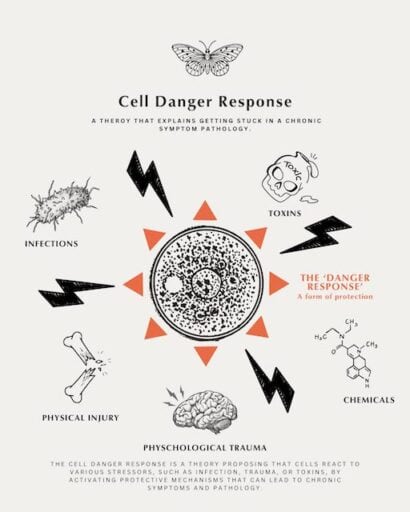The Cell Danger Response
Why Your Body Gets Stuck in Survival Mode, and How to Gently Shift Into Healing
The Cell Danger Response is one of those hidden mechanisms that quietly shapes how we feel, and how we heal. It’s a term coined by Dr Robert Naviaux, a researcher who’s been exploring chronic illness and Cell Danger Response in conditions like autism, mitochondrial disease, and more.
At its core, the Cell Danger Response is the body’s way of saying, “Something’s not right. Let’s protect you.” That might be a physical threat, an infection, emotional stress, or even subtle environmental inputs your system perceives as dangerous.
The key players are your mitochondria. You might know them as the energy-makers of your cells, and they are. But they also act as watchtowers. Constantly sensing. Constantly scanning. And when something feels off, they shift from energy production into defence mode.
In acute situations, this response is incredibly wise. It helps the body slow down, prioritise safety, and activate repair. But sometimes the danger signal never gets switched off. And that changes everything.
When Protection Gets Stuck
If the Cell Danger Response stays active, healing can’t begin. It’s as if your body is holding its breath, waiting for a sign that it’s safe to exhale.
Your mitochondria stop making energy the usual way. Instead, they send warning signals. Inflammation increases. The immune system stays on edge. Metabolism slows. And your body feels more and more stuck.
This can show up as:
- Fatigue that never really lifts
- Brain fog, mood swings, emotional fragility
- Sensitivities to food, noise, light, or chemicals
- Immune flares, rashes, or digestive issues
- A feeling that nothing is working, no matter how hard you try
These symptoms aren’t random. Your body isn’t broken. It’s just stuck in a loop of survival.
What Triggers the Cell Danger Response?
It doesn’t take a single huge trauma. Many small, ongoing stressors can add up over time. Common triggers include:
- Physical injury, surgery, or concussion
- Emotional stress, neglect, or trauma
- Chronic infections like Lyme, EBV, or COVID-19
- Mould exposure, heavy metals, or environmental toxins
- Burnout, overexertion, or lack of rest
- Nutrient depletion or poor sleep
- Ongoing nervous system dysregulation and healing disruptions
What matters isn’t just the trigger, but how the body interprets it, and whether it ever gets the message that the danger is over.
Mitochondria: More Than Just Energy Makers
Our biology was built for a world of real food, natural light, slow rhythms, and connection. Today, we live in artificial cycles. Fast, loud, disconnected.
And for sensitive systems, it’s overwhelming. The Cell Danger Response gets triggered over and over again:
- Blue light and screen time disrupting circadian rhythms
- Processed food stressing digestion
- Noise, chemicals, overstimulation
- Unresolved emotional strain
It becomes a chronic state of alert, not because your body wants to suffer, but because it’s trying to protect you from a world that doesn’t feel safe.
The Modern Mismatch
Our bodies evolved in environments of natural light, real food, deep rest, and strong social bonds. Today, that’s no longer our norm. Instead, we’re constantly exposed to:
- Artificial light and blue screens that confuse sleep cycles
- Processed foods that stress digestion
- Chronic overstimulation and noise
- Chemicals in our air, water, and homes
- Psychological stress with no off-switch
- Disconnection from nature, community, and stillness
For sensitive systems, this modern world can feel like one long emergency. The result? The CDR is triggered again and again, and the system never quite resets.
When the World Feels Unsafe
If you live with MCAS or other chronic sensitivities, you might recognise this:
A supplement causes a flare.
A scent triggers dizziness.
A normal food suddenly becomes reactive.
Shops, crowds, even conversation feel like too much.
It’s not in your head. It’s not imaginary. Your system is working overtime to keep you safe. But the protection has become a prison.
Where Healing Begins
Healing isn’t about pushing through. It’s about helping the body feel safe enough to stop bracing.
Before the body can:
- Digest food and absorb nutrients
- Regulate hormones and immunity
- Detoxify gently
- Engage with therapies
…it needs safety. Felt safety. Not just mentally, but physically, emotionally, and energetically.
That might look like:
- Grounding, breath work, and light touch
- Emotional processing and spiritual connection
- Nervous system regulation over achievement
- Rest, rhythm, and reconnection
Small, steady steps. Less doing. More being. Helping the body recognise, “I’m safe now.”
You Are Not Broken
If you feel like your body is failing you, like you’re trying everything and nothing works, know this:
You are not broken. You’re just still protecting.
Your system is wise. It has always been trying to keep you safe. Now it’s time to show it that it is safe, gently, softly, in a way it can truly receive.
When that happens, healing doesn’t need to be forced. It unfolds.
FAQs About the Cell Danger Response
It’s a protective state your body enters when it senses something’s wrong, whether that’s an infection, trauma, or long-term stress. It helps your body survive. But if that response doesn’t turn off, it can leave you stuck in survival mode.
Sometimes the body doesn’t receive a clear “all clear” signal. That can happen after long-term stress, trauma, or nervous system dysregulation. Your body stays on alert, even when the threat is gone.
Common signs include fatigue, brain fog, sensitivities, inflammation, immune issues, or persistent digestive problems. It often feels like your body is reacting to everything.
Yes, the Cell Danger Response and nervous system dysregulation and healing are deeply connected. A stressed or dysregulated system can keep the CDR active for longer.
Yes. But not through force. Healing begins with helping the body feel safe, through regulation, rest, presence, and compassion.
Often, yes. Trauma can prime the system to stay in protection. That’s why approaches that address mitochondrial dysfunction and trauma together can be so powerful.
Ready to Help Your Body Feel Safe Again?
If your body feels like it’s stuck in survival mode, you’re not alone, and you don’t have to figure it out by yourself. This isn’t about fixing or forcing. It’s about listening, softening, and finding your way back to trust.
I work with people who are ready to stop battling their bodies and begin creating safety, connection, and space for real healing.
If that’s you, let’s begin.
Contact me, the first step can be a gentle one.

